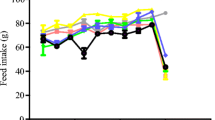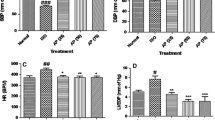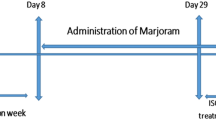Abstract
The present study was designed to evaluate possible protective effects of purified histaminase from Lathyrus sativus L. seedling on the myocardial injuries upon isoprenaline-induced myocardial infarction in rats. In this regard, blood histamine concentration, creatine kinase-MB (CK-MB) activity, antioxidant status, and histopathological changes of the hearts were measured. A total of 40 adult male Sprague–Dawley rats were divided into five equal groups and treated in the following order: control (normal saline), isoprenaline (isoproterenol 110 mg/kg BW), Isopren.-H1 (isoprenaline plus histaminase 80 U/kg BW), Isopren.-H2 (isoprenaline plus histaminase 120 U/kg BW), and Isopren.-H3 (isoprenaline plus histaminase 160 U/kg BW). Myocardial infarction was manifested by a significant elevation in the level of CK-MB and histopathological findings in isoprenaline group when compared to controls. In contrast, histaminase pretreatment at dose of 160 U/kg prevented isoprenaline-induced histamine release and significantly decreased CK-MB activity as well as histopathological changes in Isopren.-H3 group. A significant increase in the catalase (CAT) and superoxide dismutase (SOD) activities was also observed by histaminase treatment in Isopren.-H2 and Isopren.-H3 groups. Although the activity of glutathione peroxidase (GPx) increased significantly to suppress oxidative stress in isoprenaline group, it was not able to prevent lipid peroxidation (as shown by TBARS concentration) in the heart of rats. In conclusion, the plant-originated histaminase presented as a promising enzyme with antioxidant properties against histamine release and myocardial infarction in rats, and it seems be a suitable therapeutic agent for future clinical trials in humans.







Similar content being viewed by others
References
Alirezaei M, Dezfoulian O, Kheradmand A, Neamati S, Khonsari A, Pirzadeh A (2011) Hepatoprotective effects of purified oleuropein from olive leaf extract against ethanol-induced damages in the rat. Iran J Vet Res 13(3):218–226
Alirezaei M, Jelodar G, Niknam P, Ghayemi Z, Nazifi S (2011) Betaine prevents ethanol-induced oxidative stress and reduces total homocysteine in the rat cerebellum. J Physiol Biochem 67(4):605–612
Alirezaei M, Jelodar G, Ghayemi Z (2012) Antioxidant defense of betaine against oxidative stress induced by ethanol in the rat testes. Int J Pept Res Ther 18(3):239–247
Alirezaei M, Kheradmand A, Heydari R, Tanideh N, Neamati S, Rashidipour M (2012) Oleuropein protects against ethanol-induced oxidative stress and modulates sperm quality in the rat testis. Mediterr J Nutr Metab 5:205–211
Alirezaei M, Khonsari A, Neamati S, Khalighyan N, Javidnia K (2012) Purification and survey on the kinetic properties from Lathyrus sativus histaminase via anion exchange chromatography. Yafteh 14(2):31–42
Alirezaei M, Niknam P, Jelodar G (2012) Betaine elevates ovarian antioxidant enzyme activities and demonstrates methyl donor effect in non-pregnant rats. Int J Pept Res Ther 18(3):281–290
Alirezaei M, Jelodar G, Ghayemi Z, Mehr MK (2014) Antioxidant and methyl donor effects of betaine versus ethanol-induced oxidative stress in the rat liver. Comp Clin Pathol 23(1):161–168
Bertuglia S, Giusti A (2003) Microvascular oxygenation, oxidative stress, NO suppression and superoxide dismutase during postischemic reperfusion. Am J Physiol Heart Circ Physiol 285(3):H1064–H1071
Bolli R (1988) Oxygen-derived free radicals and postischemic myocardial dysfunction (stunned myocardium). J Am Coll Cardiol 12(1):239–249
Brown DD, Tomchick R, Axelrod J (1959) The distribution and properties of a histamine-methylating enzyme. J Biol Chem 234(11):2948–2950
Claiborne A (1986) Catalase activity. In: Greenwald RA (ed) CRC handbook of methods for oxygen radical research. CRC, Boca Raton, pp 283–284
Cooper R, Cutler J, Desvigne-Nickens P, Fortmann SP, Friedman L, Havlik R, Hogelin G, Marler J, McGovern P, Morosco G (2000) Trends and disparities in coronary heart disease, stroke, and other cardiovascular diseases in the United States findings of the national conference on cardiovascular disease prevention. Circulation 102(25):3137–3147
Dhandapania N (2007) Biochemical studies on the protective effect of betaine on mitochondrial function in experimentally induced myocardial infarction in rats. J Health Sci 53(6):671–681
Falus As, Grosman N, Darvas Z (2004) Histamine: biology and medical aspects. Karger Publishers, pp 25–95
Farvin KHS, Anandan R, Kumar SHS, Shiny KS, Mathew S, Sankar TV, Nair PGV (2006) Cardioprotective effect of squalene on lipid profile in isoprenaline-induced myocardial infarction in rats. J Med Food 9(4):531–536
Federico R, Cona A, Caliceti P, Veronese FM (2006) Histaminase PEGylation: preparation and characterization of a new bioconjugate for therapeutic application. J Control Release 115(2):168–174
Francis GS, Tang WHW (2006) Histamine, mast cells, and heart failure is there a connection? J Am Coll Cardiol 48(7):1385–1386
Frangogiannis NG, Lindsey ML, Michael LH, Youker KA, Bressler RB, Mendoza LH, Spengler RN, Smith CW, Entman ML (1998) Resident cardiac mast cells degranulate and release preformed TNF-a, initiating the cytokine cascade in experimental canine myocardial ischemia/reperfusion. Circulation 98(7):699–710
Frattini V, Lionetti C (1998) Histamine and histidine determination in tuna fish samples using high-performance liquid chromatography: derivatization with o-phthalaldehyde and fluorescence detection or UV detection of free species. J Chromatogr A 809(1):241–245
Ganesan B, Anandan R (2009) Protective effect of betaine on changes in the levels of lysosomal enzyme activities in heart tissue in isoprenaline-induced myocardial infarction in Wistar rats. Cell Stress Chaperones 14(6):661–667
Ganesan B, Buddhan S, Anandan R, Sivakumar R, Anbinezhilan R (2010) Antioxidant defense of betaine against isoprenaline-induced myocardial infarction in rats. Mol Biol Rep 37(3):1319–1327
Geetha A, Sankar R, Marar T, Devi CS (1990) Alpha-tocopherol reduces doxorubicin-induced toxicity in rats–histological and biochemical evidences. Ind J Physiol Pharmacol 34(2):94–100
Gourine AV, Gonon AT, Pernow J (2001) Involvement of nitric oxide in cardioprotective effect of endothelin receptor antagonist during ischemia-reperfusion. Am J Physiol Heart Circ Physiol 280(3):H1105–H1112
Gupta MK, Gupta P, Rezai F (2001) Histamine—can it cause an acute coronary event? Clin Cardiol 24(3):258–259
Jaydari F, Johari H, Taati M, Asadian P, Alirezaei M, Sheikhzadeh F (2011) The effects of Ziziphus jujuba fruit extract on catalase activity and lipid peroxidation in the heart and erythrocytes of rats following chronic ethanol consumption. Int J Vet Res 5(2):125–128
Kheradmand A, Alirezaei M, Birjandi M (2010) Ghrelin promotes antioxidant enzyme activity and reduces lipid peroxidation in the rat ovary. Regul Pept 162(1–3):84–89
Kheradmand A, Alirezaei M, Dezfoulian O (2013) Cadmium-induced oxidative stress in the rat testes: protective effects of betaine. Int J Pept Res Ther 19:337–344
Kounis NG, Zavras GM (1991) Histamine-induced coronary artery spasm: the concept of allergic angina. Br J Clin Pract 45(2):121
Lantoine F, Iouzalen L, Devynck M, Millanvoye-Van Brussel E, David-Dufilho M (1998) Nitric oxide production in human endothelial cells stimulated by histamine requires Ca2+ influx. Biochem J 330:695–699
Levrand S, Vannay-Bouchiche C, Pesse B, Pacher P, Feihl F, Waeber B, Liaudet L (2006) Peroxynitrite is a major trigger of cardiomyocyte apoptosis in vitro and in vivo. Free Radic Biol Med 41(6):886–895
Li XS, Uriuda Y, Wang QD, Nordlander R, Sjoquist PO, Pernow J (1996) Role of l-arginine in preventing myocardial and endothelial injury following ischaemia/reperfusion in the rat isolated heart. Acta Physiol Scand 156(1):37–44
Li H, Burkhardt C, Heinrich U-R, Brausch I, Xia N, Forstermann U (2003) Histamine upregulates gene expression of endothelial nitric oxide synthase in human vascular endothelial cells. Circulation 107(18):2348–2354
Lobo Filho HG, Ferreira NL, Sousa RB, Carvalho ER, Lobo PLD, Lobo Filho JG (2011) Experimental model of myocardial infarction induced by isoproterenol in rats. Rev Bras Cir Cardiovasc 26(3):469–476
Lowry OH, Rosebrough NJ, Farr AL, Randall RJ (1951) Protein measurement with the Folin phenol reagent. J Biol Chem 193(1):265–275
Maintz L, Novak N (2007) Histamine and histamine intolerance. Am J Clin Nutr 85(5):1185–1196
Masini E, Salvemini D, Ndisang JF, Gai P, Berni L, Moncini M, Bianchi S, Mannaioni PF (1999) Cardioprotective activity of endogenous and exogenous nitric oxide on ischaemia reperfusion injury in isolated guinea pig hearts. Inflamm Res 48(11):561–568
Masini E, Vannacci A, Marzocca C, Francesco Mannaioni P, Befani O, Federico R, Toma A, Mondovi B (2002) A plant histaminase modulates cardiac anaphylactic response in guinea pig. Biochem Biophys Res Commun 296(4):840–846
Masini E, Pierpaoli S, Marzocca C, Mannaioni PF, Pietrangeli P, Mateescu MA, Zelli M, Federico R, Mondovi B (2003) Protective effects of a plant histaminase in myocardial ischaemia and reperfusion injury in vivo. Biochem Biophys Res Commun 309(2):432–439
Masini E, Danielle B, Cosimo M, Alexandru MM, Francesco MP, Rodolfo F, Bruno M (2007) Pea seedling histaminase as a novel therapeutic approach to anaphylactic and inflammatory disorders. Sci World J 7:888–902
Matheis G, Sherman MP, Buckberg GD, Haybron DM, Young HH, Ignarro LJ (1992) Role of L-arginine-nitric oxide pathway in myocardial reoxygenation injury. Am J Physiol Heart Circ Physiol 262(2):H616–H620
Mueen Ahmed KK, Rana AC, Dixit VK (2004) Effect of Calotropis procera latex on isoproterenol induced myocardial infarction in albino rats. Phytomedicine 11(4):327–330
Neamati S, Alirezaei M, Kheradmand A (2011) Ghrelin acts as an antioxidant agent in the rat kidney. Int J Pept Res Ther 17(3):239–245
Pierpaoli S, Marzocca C, Bello MG, Schunack W, Mannaioni PF, Masini E (2003) Histaminergic receptors modulate the coronary vascular response in isolated guinea pig hearts. Role of nitric oxide. Inflamm Res 52(9):390–396
Sangeetha T, Quine SD (2006) Preventive effect of S-allyl-cysteine sulfoxide (alliin) on cardiac marker enzymes and lipids in isoproterenol-induced myocardial injury. J Pharm Pharmacol 58(5):617–623
Schulz R, Wambolt R (1995) Inhibition of nitric oxide synthesis protects the isolated working rabbit heart from ischaemia-reperfusion injury. Cardiovasc Res 30(3):432–439
Simmons TW, Jamall IS (1989) Relative importance of intracellular glutathione peroxidase and catalase in vivo for prevention of peroxidation to the heart. Cardiovasc Res 23(9):774–779
Singh M, Saini HK (2003) Resident cardiac mast cells and ischemia-reperfusion injury. J Cardiovasc Pharmacol Ther 8(2):135–148
Stremoukhov AA (2001) Histamine-dependent changes in free radical processes during coronary heart disease. Bull Exp Biol Med 132(6):1157–1159
Subbarao KV, Richardson JS, Ang LC (1990) Autopsy samples of Alzheimer's cortex show increased peroxidation in vitro. J Neurochem 55(1):342–345
Toda N (1987) Mechanism of histamine actions in human coronary arteries. Circ Res 61(2):280–286
Valen G, Kaszaki J, Szabo I, Nagy S, Vaage J (1996) Activity of histamine metabolizing and catabolizing enzymes during reperfusion of isolated, globally ischemic rat hearts. Inflamm Res 45(3):145–149
Vimal V, Devaki T (2004) Linear furanocoumarin protects rat myocardium against lipid peroxidation and membrane damage during experimental myocardial injury. Biomed Pharmacother 58(6):393–400
Wu L, Mateescu M-A, Wang X-T, Mondovi B, Wang R (1996) Modulation of K+ channel currents by serum amine oxidase in neurons. Biochem Biophys Res Commun 220(1):47–52
Zappia V, Pegg AE (1988) Progress in polyamine research. International Symposium on Polyamines in Biochemical and Clinical Research (1988: Sorrento, Italy), Plenum Press. pp:54–56
Zdravkovic V, Pantovic S, Rosic G, Tomic-Lucic A, Zdravkovic N, Colic M, Obradovic Z, Rosic M (2011) Histamine blood concentration in ischemic heart disease patients. Biomed Res Int 2011
Acknowledgments
This study was financially supported by research Project No = 91/5 of Razi Herbal Medicines Research Center, Lorestan University of Medical Sciences, Khorramabad, Iran.
Conflict of interest
The authors declare that they have no conflict of interest.
Animal studies
All rats were treated humanely and in compliance with the recommendations of Animal Care Committee for Lorestan University of Medical Sciences (Khorramabad, Iran) with Approval Number: SM 9132.
Author information
Authors and Affiliations
Corresponding author
Electronic supplementary material
Below is the link to the electronic supplementary material.
ESM 1
(DOC 115 kb)
Rights and permissions
About this article
Cite this article
Alirezaei, M., Delfan, B., Dezfoulian, O. et al. The plant histaminase: a promising enzyme with antioxidant properties versus histamine release in isoprenaline-induced myocardial infarction in rats. J Physiol Biochem 70, 837–847 (2014). https://doi.org/10.1007/s13105-014-0352-1
Received:
Accepted:
Published:
Issue Date:
DOI: https://doi.org/10.1007/s13105-014-0352-1




